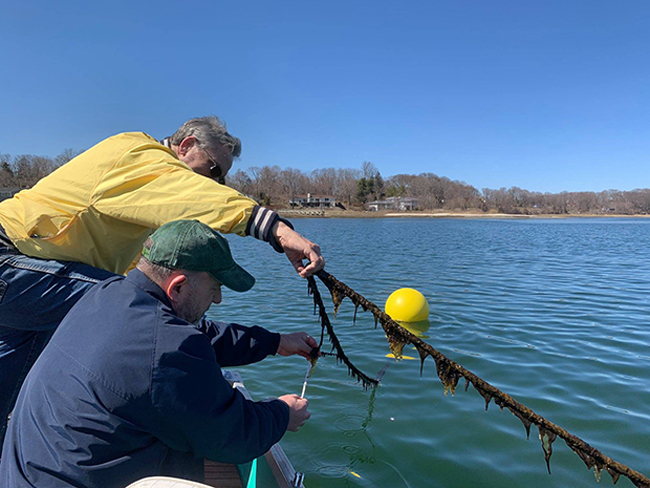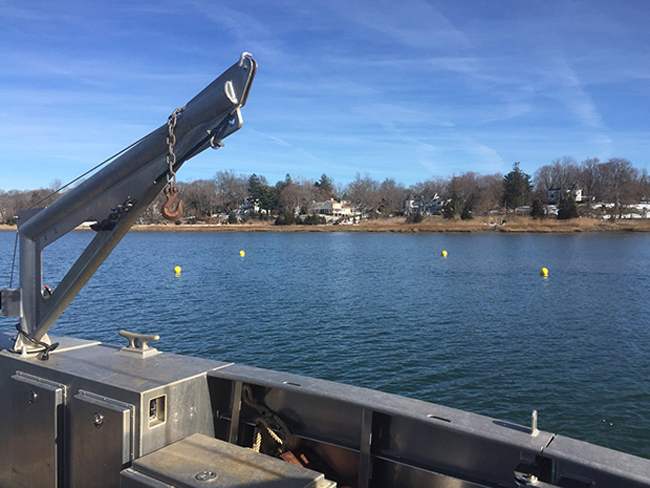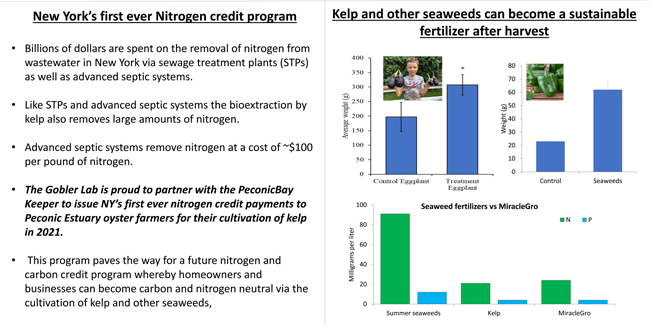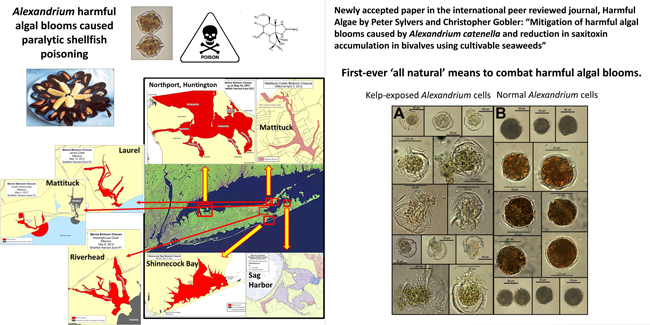
— Filed by Stony Brook News; SBU's School of Marine and Atmospheric Sciences
Stony Brook, NY, June 4, 2021 - Using kelp to help reduce nitrogen in Long Island waters was the subject of a May 27th press conference at the School of Marine and Atmospheric Sciences (SoMAS) Marine Science Center at Stony Brook Southampton.
Christopher Gobler, Endowed Chair of Coastal Ecology and Conservation at SoMAS, spoke about a funding program that would be the first in New York State to offer “nitrogen credit” payments for kelp cultivation. This past winter, oyster farmers cultivated experimental kelp beds to study kelp’s role in reducing nitrogen, and they will receive the first-time payments for their 2021 harvest.
Gobler said kelp — grown in the winter months when boaters are less active on local waterways and an efficient consumer of nitrogen and carbon dioxide — can be a very effective tool in reducing nitrogen in local waters while large-scale introduction of advanced septic systems is phased in over the next few decades.
“We need solutions right now to protect water quality,” he said in a Newsday article on the press conference.

Checking on the sugar kelp harvest in early Spring 2021. Credit: Setauket Harbor Task Force
Gobler said his lab has used grant money over the past three years to cultivate sugar kelp on 10 different oyster farms, producing 10,000 pounds of kelp while removing 36 pounds of nitrogen. The program would have kelp farmers potentially produce more than 70,000 pounds of kelp on one-acre farms, and help extract 200 pounds of nitrogen from the waters, earning hundreds of dollars of credits during a season they are largely off the water.
Gobler’s lab has also made advances in the production of fertilizer from kelp, developing a product that has the same nitrogen and phosphorus content as popular garden fertilizers. “The next step is to scale up and make it commercially viable,” he told Newsday, envisioning a day when “we won’t need to import synthetic fertilizers on Long Island.”
Currently only around 1,000 to 1,500 such systems have been deployed in Suffolk. Gobler said 220,000 such systems are expected to be deployed by 2050.

Setauket Harbor Task Force's sugar kelp lines in the northeast part of Setauket Harbor. The two 100 foot lines are marked with yellow floating markers. Credit Setauket Harbor Task Force
More Info: Gobler Lab — The Promise of Kelp and Seaweeds for Protecting Long Island’s Coastal Ecosystems

Southampton, NY, May 27, 2021 - The past four-decades have witnessed a progressive degradation of Long Island’s coastal ecosystems.
Nitrogen levels have risen by 50 – 90% in groundwater and surface waters, mainly due to a density that would make Long Island the 10th most densely population nation, and the prevalence of onsite septic systems that do not remove nitrogen. These high nitrogen levels have had a cascading negative effect on coastal ecosystems, initiating harmful algal blooms (HABs) that can poison humans or marine life, the collapse of shellfish exposed to HABs, the shading out and loss of seagrass, and low oxygen and pH levels that can further danger marine life. This has already been extremely evident in 2021, as this week, a dangerous Mahogany tide has spread across the south shore and east end of Long Island, endangering shellfish and other marine life.
While New York State and Suffolk County has taken extremely progressive actions to remove nitrogen from onsite wastewater and septic systems, it will take decades for these actions to exact their effects given the pace of such upgrades and the travel time of groundwater. Therefore, actions that can immediately remove nitrogen from surface waters before they lead to water quality impairment and fisheries collapses are desperately needed.
The cultivation of kelp holds the promise to do that and more and a series of key discoveries and programs by the Gobler Laboratory at the School and Marine and Atmospheric Sciences at Stony Brook University have demonstrated the efficacy of kelp cultivation as a means to protect water quality, oysters farms, and ecosystems in Long Island’s surface waters.

During the past three years, the Gobler Laboratory has successfully grown kelp on 10 oyster farms across Long Island and the outcomes have exceeded expectations.
This week marked the removal of 10,000 pounds of kelp from Long Island waters since 2019. With this removal came more than 36 pounds of nitrogen, the equivalent of three advanced, nitrogen removing septic systems.
In the near future, the implementation of larger, one-acre kelp farms could create 70,000 pounds of kelp annually and the extraction 200 pounds of nitrogen, the equivalent of up to 20 advanced septic systems.
The recent studies have proven that kelp can be grown in both shallow and deep waters and kelp removed more nitrogen in high-nitrogen regions, meaning kelp can be strategically placed in regions most in need of nitrogen removal.
To incentivize the removal of nitrogen via kelp farming, today the Gobler Lab announces a partnership with the PeconicBay Keeper to issue NY’s first ever nitrogen credit payments to Peconic Estuary oyster farmers for their cultivation of kelp in 2021.
Nitrogen credits provide another revenue stream and incentive for marine farmers to grow seaweeds that makes seaweed cultivation more profitable and acknowledges the significant environmental services (e.g. removal of nitrogen and carbon, combating ocean acidification and harmful algal blooms) performed by seaweed farming.
The Gobler Lab has received kelp from farmers and is now measuring the carbon and nitrogen content as well as total weight of the kelp and the program will provide farmers with a set amount of money on a per pound nitrogen basis and will pay oyster farmers on this basis for 2021.
This credit program is the first of its kind in NY and emphasizes the environmental benefits of kelp. Beyond 2021, the Gobler Lab will work to expand this program in the future to homeowners and businesses that could purchase nitrogen credits by supporting kelp aquaculture to become nitrogen neutral.
The Gobler Lab has further made advances in converting harvest kelp into fertilizers. During the past five years, the Gobler Lab have refined and perfected the creation of liquid and dried fertilizers that have nitrogen and phosphorus contents that match or exceed the contents of commercial fertilizers such as MiraclGro. Moreover, these fertilizers have been shown to provide the growth and yields of flowering plants and vegetables that significantly exceed unfertilized treatments and can match the performance of commercial fertilizers. Efforts are now underway by the Gobler Lab to convert these fertilizers into large scale production for commercial use.

Finally, while kelp have been shown to remove nitrogen and combat ocean acidification, the Gobler Lab has recently made a first-ever discovery in a manner in how seaweeds can combat harmful algal blooms.
In the newly accepted paper in the international peer reviewed journal, Harmful Algae by Peter Sylvers and Christopher Gobler entitled “Mitigation of harmful algal blooms caused by Alexandrium catenella and reduction in saxitoxin accumulation in bivalves using cultivable seaweeds”, the authors demonstrate that kelp can fight off the most toxic and dangerous harmful algal bloom in NY. Alexandrium harmful algal blooms caused paralytic shellfish poisoning that can be lethal and has caused shellfish bed closures at seven locations across NY during that past decade.
In this study the authors demonstrate that sugar kelp can reduced Alexandrium densities by 60-95% in experiments. The sugar kelp was also capable of reducing the accumulation of saxitoxin in mussels below the US FDA closure limit for bivalves.
Collectively, the study demonstrates that the aquaculture of seaweeds represents an environmentally friendly and potentially profit-generating measure to mitigate A. catenella-caused damage to the shellfish aquaculture and harvesting industries.
This research was sponsored by Suffolk County, New York Sea Grant, the New York Farm Viability Institute, and USDA.

More Info: New York Sea Grant
New York Sea Grant (NYSG), a cooperative program of Cornell University
and the State University of New York (SUNY), is one of 34 university-based
programs under the National Oceanic and Atmospheric Administration’s
National Sea Grant College Program.
Since 1971, NYSG has represented a statewide network of integrated
research, education and extension services promoting coastal community
economic vitality, environmental sustainability and citizen awareness
and understanding about the State’s marine and Great Lakes resources.
Through NYSG’s efforts, the combined talents of university scientists
and extension specialists help develop and transfer science-based
information to many coastal user groups—businesses and industries,
federal, state and local government decision-makers and agency managers,
educators, the media and the interested public.
The program maintains Great Lakes offices at Cornell University, SUNY
Buffalo, SUNY Oswego and the Wayne County Cooperative Extension office
in Newark. In the State's marine waters, NYSG has offices at Stony Brook
University in Long Island, Brooklyn College and Cornell Cooperative
Extension in NYC and Kingston in the Hudson Valley.
For updates on Sea Grant activities: www.nyseagrant.org has RSS, Facebook, Twitter, Instagram, and YouTube links. NYSG offers a free e-list sign up via www.nyseagrant.org/nycoastlines for its flagship publication, NY Coastlines/Currents, which is published quarterly.